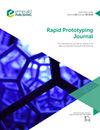Efficient toolpath planning for collaborative material extrusion machines
IF 3.6
4区 工程技术
Q1 ENGINEERING, MECHANICAL
引用次数: 0
Abstract
Purpose Timing constraints affect the manufacturing of traditional large-scale components through the material extrusion technique. Thus, researchers are exploring using many independent and collaborative heads that may work on the same part simultaneously while still producing an appealing final product. The purpose of this paper is to propose a simple and repeatable approach for toolpath planning for gantry-based n independent extrusion heads with effective collision avoidance management. Design/methodology/approach This research presents an original toolpath planner based on existing slicing software and the traditional structure of G-code files. While the computationally demanding component subdivision task is assigned to computer-aided design and slicing software to build a standard G-code, the proposed algorithm scans the conventional toolpath data file, quickly isolates the instructions of a single extruder and inserts brief pauses between the instructions if the non-priority extruder conflicts with the priority one. Findings The methodology is validated on two real-life industrial large-scale components using architectures with two and four extruders. The case studies demonstrate the method's effectiveness, reducing printing time considerably without affecting the part quality. A static priority strategy is implemented, where one extruder gets priority over the other using a cascade process. The results of this paper demonstrate that different priority strategies reflect on the printing efficiency by a factor equal to the number of extrusion heads. Originality/value To the best of the authors’ knowledge, this is the first study to produce an original methodology to efficiently plan the extrusion heads' trajectories for a collaborative material extrusion architecture.协同材料挤出机的高效刀具路径规划
目的时间约束通过材料挤出技术影响传统大型零部件的制造。因此,研究人员正在探索使用许多独立和协作的头脑,这些头脑可以同时处理同一个零件,同时仍然生产出有吸引力的最终产品。本文的目的是提出一种简单且可重复的方法,用于基于龙门架的n个独立挤压头的刀具路径规划,并具有有效的碰撞避免管理。设计/方法论/方法本研究基于现有的切片软件和传统的G代码文件结构,提出了一种独创的刀具路径规划器。虽然计算要求很高的部件细分任务被分配给计算机辅助设计和切片软件来构建标准的G代码,但所提出的算法扫描传统的刀具路径数据文件,快速隔离单个挤出机的指令,并在非优先级挤出机与优先级挤出机冲突时在指令之间插入短暂的停顿。发现该方法在两个真实的工业大型组件上使用两个和四个挤出机的架构进行了验证。案例研究证明了该方法的有效性,在不影响零件质量的情况下大大缩短了打印时间。实施静态优先策略,其中一台挤出机使用级联过程获得优先权。本文的结果表明,不同的优先级策略对打印效率的影响因子等于挤出头的数量。独创性/价值据作者所知,这是第一项为协同材料挤出架构有效规划挤出头轨迹的独创方法的研究。
本文章由计算机程序翻译,如有差异,请以英文原文为准。
求助全文
约1分钟内获得全文
求助全文
来源期刊

Rapid Prototyping Journal
工程技术-材料科学:综合
CiteScore
8.30
自引率
10.30%
发文量
137
审稿时长
4.6 months
期刊介绍:
Rapid Prototyping Journal concentrates on development in a manufacturing environment but covers applications in other areas, such as medicine and construction. All papers published in this field are scattered over a wide range of international publications, none of which actually specializes in this particular discipline, this journal is a vital resource for anyone involved in additive manufacturing. It draws together important refereed papers on all aspects of AM from distinguished sources all over the world, to give a truly international perspective on this dynamic and exciting area.
-Benchmarking – certification and qualification in AM-
Mass customisation in AM-
Design for AM-
Materials aspects-
Reviews of processes/applications-
CAD and other software aspects-
Enhancement of existing processes-
Integration with design process-
Management implications-
New AM processes-
Novel applications of AM parts-
AM for tooling-
Medical applications-
Reverse engineering in relation to AM-
Additive & Subtractive hybrid manufacturing-
Industrialisation
 求助内容:
求助内容: 应助结果提醒方式:
应助结果提醒方式:


